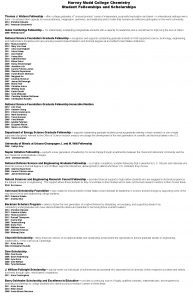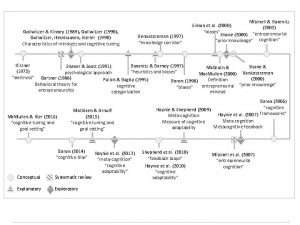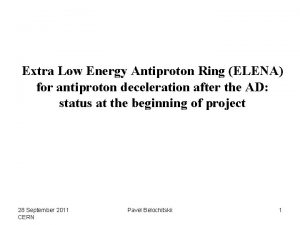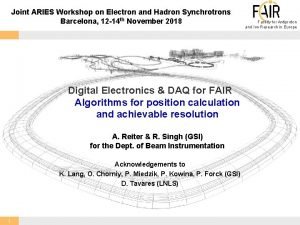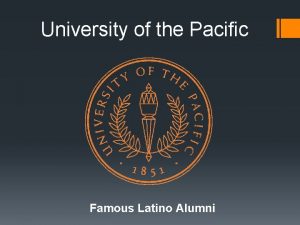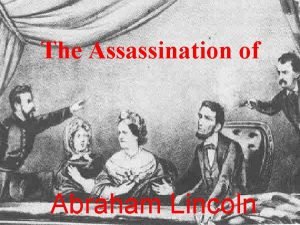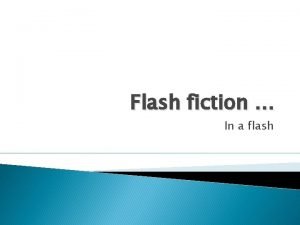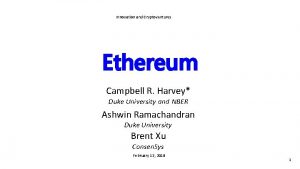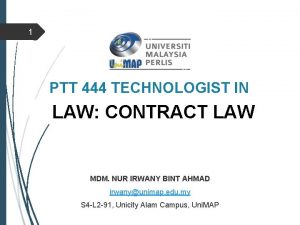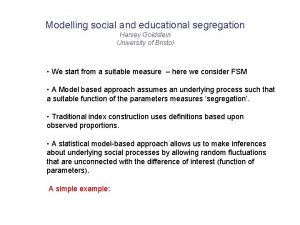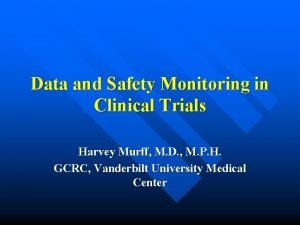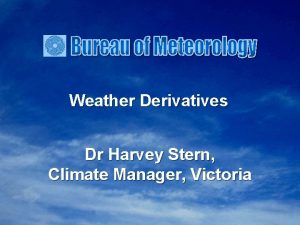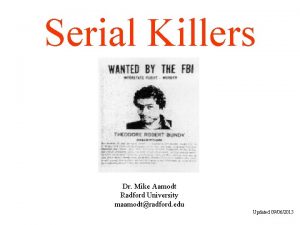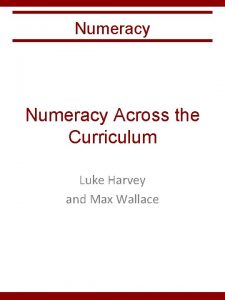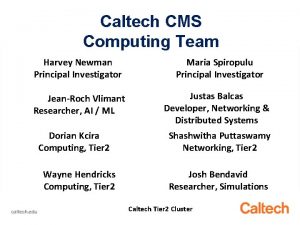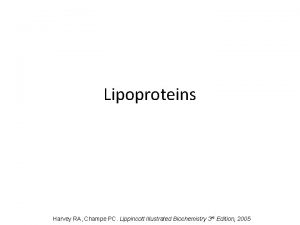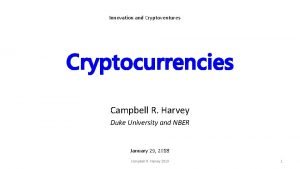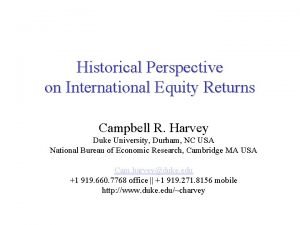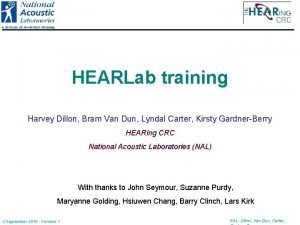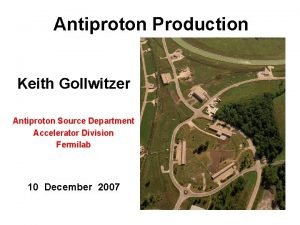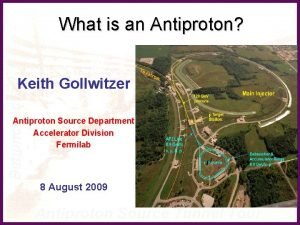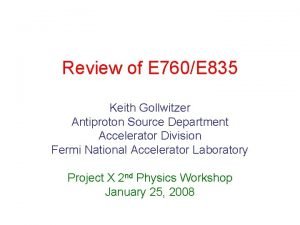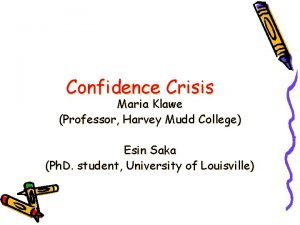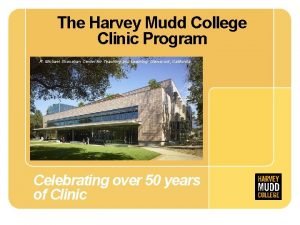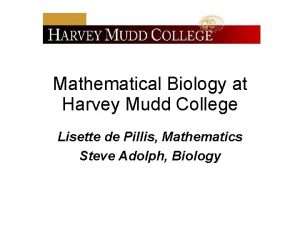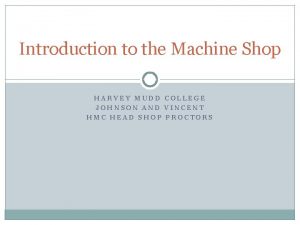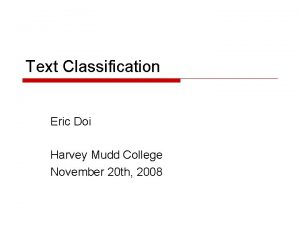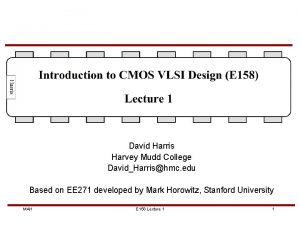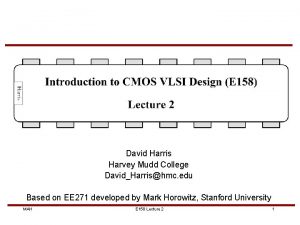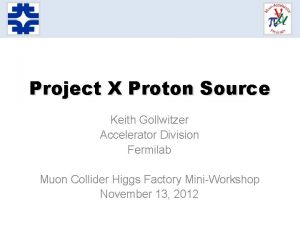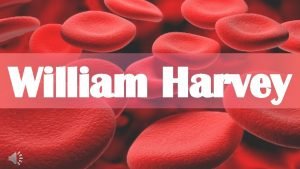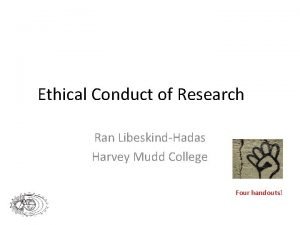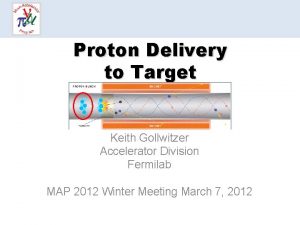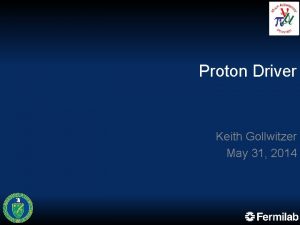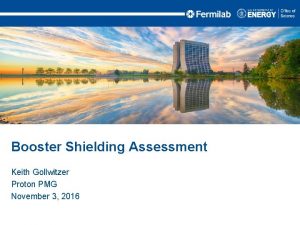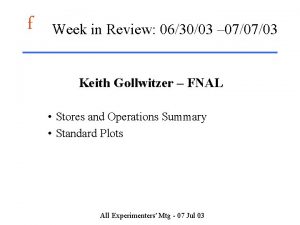Harvey Mudd College Alumni Keith Gollwitzer Antiproton Source




































- Slides: 36

Harvey Mudd College Alumni Keith Gollwitzer Antiproton Source Department Accelerator Division Fermilab 6 October 2007

My Bio • Grew up in San Jose • Harvey Mudd 1986; Physics – Senior Thesis: “Calibration of Microradian Tilts” • University of California Irvine 1993 – “The Charmonium 1 P 1 State (hc) Produced in Antiproton-Proton Annihilations” • Research/Work – – Simulations for proposed experiments SNO and LCD Three rounds of Fermilab’s Charmonium experiment Antihydrogen at Fermilab Antiproton production for the Tevatron Collider program

Founding of Fermilab • The National Accelerator Laboratory started in the 1960 s and was finished in the early 1970 s and renamed. • Founding Director Robert Rathburn Wilson Harvey Mudd College Connection? 1986 Wright Prize Winner

Wright Prize Winner Wilson

Quick Fermilab History • Originally, high energy Fixed Target Experiments • Late 1970 s-1980 s built “Energy Doubler” / “Energy Saver” / Tevatron and Antiproton Source so can have collider program • Can now run collider and fixed target programs at the same time • Some discoveries: Bottom quark, Top quark; Tau neutrino


What is an Antiproton? uud --Antiquarks • Government issued Webster’s Dictionary: – “The antiparticle of the proton” • Antiparticle definition “subatomic particle having the same mass, average lifetime, spin, magnitude of magnetic moment but opposite direction, magnitude of electric charge but opposite sign, opposite intrinsic parity” • What about “Antimatter”? – “Matter made from antiparticles” • What is a Pbar? – Shortened name for Antiproton based upon symbol used in physics p for proton – Over-line or bar above symbol means “anti” p for antiproton

Protons and Antiprotons • Protons – Plentiful – Get “free” protons by separating hydrogen components • 13. 6 e. V to ionize electron from proton • Antiprotons – Scarce in nature • Created by cosmic rays interacting with the atmosphere. – The original “Fixed Target” experiment • Particle and Antiparticle when they met --- annihilate – One big physics question is why there is so little antimatter – Dan Brown……later

Particle Collisions • Originally studied Cosmic Ray Particles Cosmic rays are energetic • No human control of energy, type, when – Detection done at high altitudes – Discovered many types of particles that are not everyday matter • Accelerators allow control of collisions – Allowed study of many new particles • Some with masses greater than the initial particles

Fermilab Collisions • Fixed Target – In the Fixed Target mode, ½ of the experiment is at rest. – The other ½ is moving at high energy. – There is a big “relativistic” penalty to be paid because of the conservation of momentum. • Collider Mode – In the Collider mode, two particles of equal mass and energy travel directly at each other. – The total momentum of the system is zero, so there is no “relativistic” penalty to be paid. – Most of the energy goes directly into making new particles.

Particle Acceleration • A charged particle will be accelerated by a voltage potential. + – Opposite charges attract. • One electron Volt (e. V) is the energy gained by an electron (or any particle of unit charge) when it is accelerated through a potential of 1 Volt. -

To Higher Energies Scientific Prefixes K (kilo) 1, 000 M (mega) 1, 000 G (giga) 1, 000, 000 T (tera) 1, 000, 000 Te. Vatron accelerates beam to nearly 1 trillion electron Volts Batteries are 1 Volt per inch A trillion inches is 15. 8 million miles. Te. V proton velocity is 0. 9999956 c

First Stage of the Acceleration • Crockoft-Walton Accelerator – Can be thought of as a 750, 000 V DC voltage source. – The maximum voltage is limited by how much the air can “stand-off” before sparking.

Second Stage of Acceleration • A linear accelerator (LINAC)

Drift Tube Linac

Synchrotrons • • The Fermilab Linac is 130 meters long and reaches an energy of 400 Me. V (1 million Volts per foot) To get to 980 billion volts, a Linac would have to be – 200 miles long at 1 million Volts per foot • What about using the Linac over and over? – The drift tube spacing at the beginning of the Linac would be wrong for higher energy particles • But a Synchrotron could be used! – Dipoles are used to bend particles – Quadrupoles are used to focus particles – RF cavities are used to accelerate particles

Dipole Magnets • Dipole magnets are used to bend the particle’s path • The magnet body confines or concentrates the magnetic field • The pole faces shape the magnetic field

Quadrupole Magnets • Quadrupoles are needed for focusing particles • Not all the particles are on the “perfect” orbit. – If the particle is on the right orbit – don’t bend. – If the particle is on the inside – bend to the outside. – If the particle is on the outside – bend to the inside.

Pre-Acc First stage of acceleration Start with Hydrogen Bottle Final Energy = 750 Ke. V

Linac Final Energy of 400 Me. V

Booster Ring Final Energy of 8 Ge. V Uses combined function magnets

Main Injector Ring Final Energy of 150 Ge. V 2 mile circumference Upper ring is the Recycler

Final Energy of 980 Ge. V Tevatron Ring 4 mile circumference Uses cryogenic superconducting dipoles

Fixed Target Beam Lines Fixed Target program has run at 800 Ge. V and currently at 120 Ge. V Neutrino Program runs at two different energies 8 Ge. V and 120 Ge. V

Antiproton Source 120 Ge. V protons from Main Injector hit (fixed) production target. Antiproton Source beam lines and rings capture and collect 8 Ge. V pbars are sent to the rest of accelerator complex to be injected into the Tevatron for the collider program

The Antiproton Target Station 29 cm 81 cm Pulsed Magnet Li Lens Nickel Alloy with air cooling through the copper disks After Before Target 3°

The Antiproton Target Station 29 cm 81 cm Pulsed Magnet Li Lens Target 3°

Stacking Cycle - Debuncher • Every 2. 2 seconds – 8 x 1012 (8 trillion) 120 Ge. V protons onto target – Beam line transfers negatively charged 8 Ge. V particles to the Debuncher 8 (200 million) 8 Ge. V – 2 x 10 • Other particles decay or pbars circulate in the radiate away in a few turns Debuncher • Beam circulates every 1. 6 microseconds – 0. 0000016 seconds • Stochastic cooling reduces the phase space by a factor of ten – Transfer all pbars to the Accumulator

Stacking Cycle - Accumulator • RF system decelerates from injection to deposition orbit • Stochastic Cooling • 2 -4 GHz stacktail – Pushes and compresses beam into the core • 2 -4 & 4 -8 GHz core momentum – Gathers beam from the stacktail • 4 -8 GHz transverse slotted waveguide pickups Cyan = After injection before RF capture Green = After RF is turned off – Increase particle density by factor of 5000 – Factor of 3 -5 decrease in both transverse phase space dimensions

Total Antiprotons at Fermilab • Accumulation rate of 2 x 1011 (200 billion) pbars per hour • When reach 5 x 1011 (500 billion) pbars, transfer beam out of the Accumulator to the Main Injector into the Recycler Ring for storage until needed for the Tevatron collider program • Most number of antiprotons that have been on site at Fermilab at one time (Accumulator, p Recycler and Tevatron) – 6 x 1012 (6 trillion) pbars • 10 pg = 0. 000 000 01 grams • This last year produced – 825 trillion pbars (1. 4 ng) p p p

Dan Brown and Antiprotons • Page of “Facts” in a book of fiction • Fact: 0. 5 grams of antiprotons mixed with 0. 5 grams of protons would produce an explosion equivalent Hiroshima • Fiction: Can easily produce, capture and transport that much antimatter – Fact: Fermilab’s bottles are over 6 miles of rings and would take 80 million years • It would cost a lot *2940 trillion $ ~ 420 x U. S. GNP

Using Antiprotons • Antiprotons are collected in Recycler Ring at 8 Ge. V for a day • Then antiprotons are sent in 36 batches to Main Injector to be accelerated to 150 Ge. V • Antiprotons are transferred to the Tevatron which already has 36 proton batches • Both beams are accelerated to 980 Ge. V

Tevatron Collider • Two beams in one accelerator going in opposite directions! – Electrostatic separators keep beams on different helical orbits during acceleration • Bring beams into collisions by collapsing helix orbits at desired interaction points – Middle of detectors

Fun Numbers • The maximum Tevatron intensity is 20 trillion particles – 20 trillion particles “weighs” about 30 trillionths of a gram • 20 trillion particles at 980 Ge. V – Has the same kinetic energy as a 200 lb. man traveling at 550 miles/hour – Has the momentum equivalent to 1 oz. of mass traveling at 1 mile/hour – Would deliver a radiation dose of 35, 000 Rads. to a 200 lb. man • 10, 000 x the acceptable yearly dose at Fermilab • Several levels of safety to keep people out of enclosures when beam may be present.

Safety You will be on tours in different areas – Including into the Antiproton Source tunnel • No smoking, eating or drinking in the tunnel enclosure • Please be careful on the stairs and walking – Edges of components and cables do stick out Tunnel is hot – 90 o. F!

Today Enjoy your time at Fermilab Please take pictures Please ask questions Hope that you have learned a little about antiprotons, particle accelerators and what goes on at Fermilab
 Workday ambassadors
Workday ambassadors Harvey mudd chemistry
Harvey mudd chemistry Hmmm assembly language
Hmmm assembly language Gollwitzer 1990
Gollwitzer 1990 Low energy antiproton ring
Low energy antiproton ring Antiproton
Antiproton San joaquin delta college notable alumni
San joaquin delta college notable alumni El camino college notable alumni
El camino college notable alumni Why did booth stop at mudd farm?
Why did booth stop at mudd farm? Harvey tuch
Harvey tuch Lou harvey leeds
Lou harvey leeds Harvey daniels literature circles
Harvey daniels literature circles Currents hannah bottomy
Currents hannah bottomy Harvey nash hanoi
Harvey nash hanoi Innovation and cryptoventures
Innovation and cryptoventures Harvey vs facey case summary
Harvey vs facey case summary Mohori bibee vs dharmodas ghose
Mohori bibee vs dharmodas ghose Contract capacity
Contract capacity Harvey goldstein singapore
Harvey goldstein singapore J harvey rodgers school
J harvey rodgers school Harvey rise to power
Harvey rise to power Dsmp
Dsmp Dr ben harvey
Dr ben harvey Dr harvey stern
Dr harvey stern Serial killers by decade
Serial killers by decade How did harvey maxwell propose miss leslie
How did harvey maxwell propose miss leslie Dr luke harvey
Dr luke harvey Dr chris harvey
Dr chris harvey Harvey newman caltech
Harvey newman caltech Alistair harvey
Alistair harvey Harvey
Harvey Josie harvey
Josie harvey Innovation and cryptoventures
Innovation and cryptoventures Campbell harvey
Campbell harvey Bram van dun
Bram van dun Harvey carr funcionalismo
Harvey carr funcionalismo David harvey china
David harvey china

